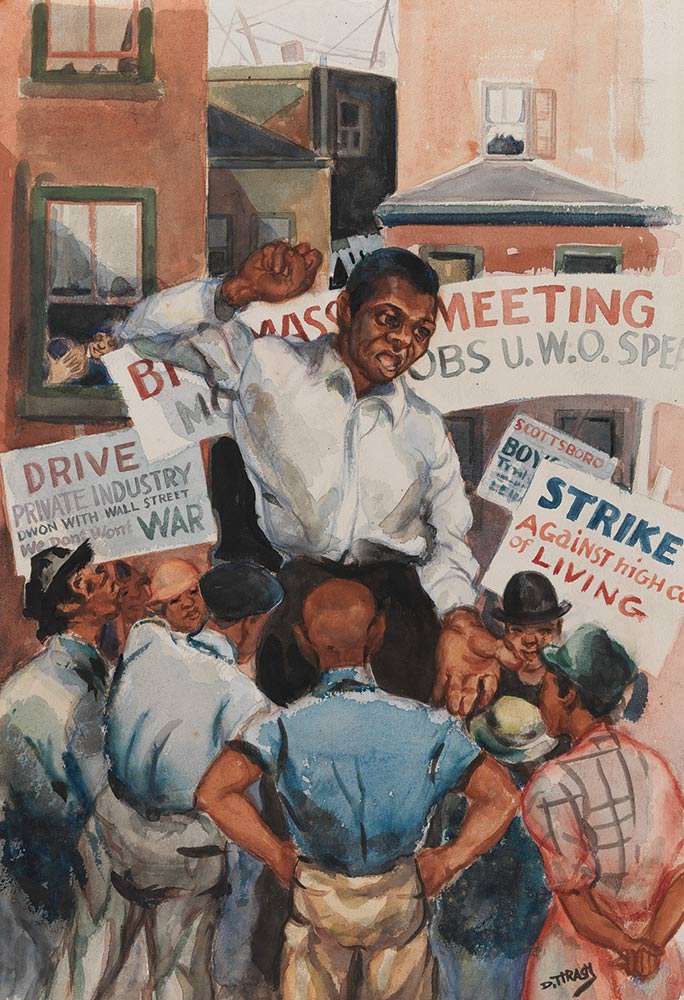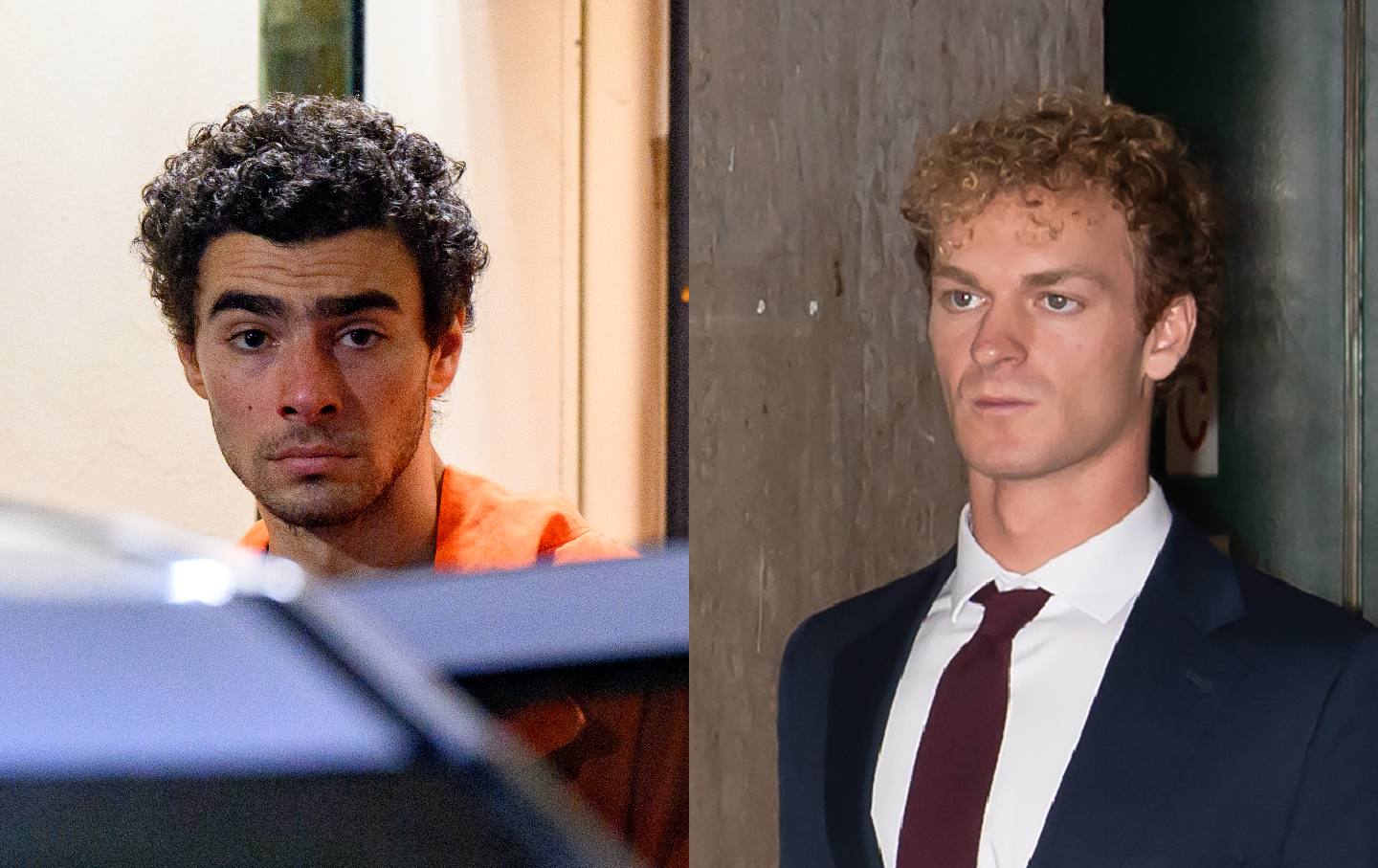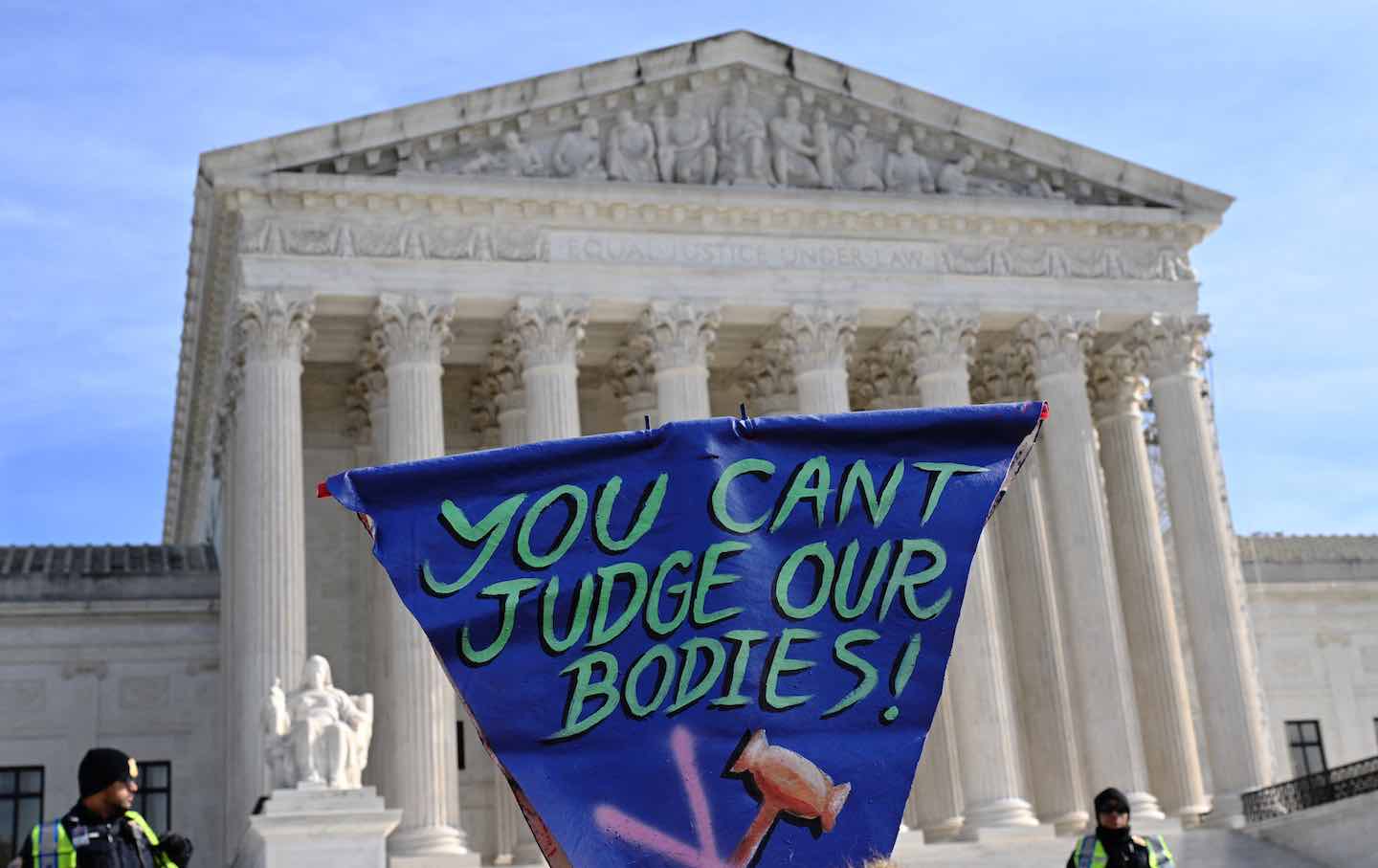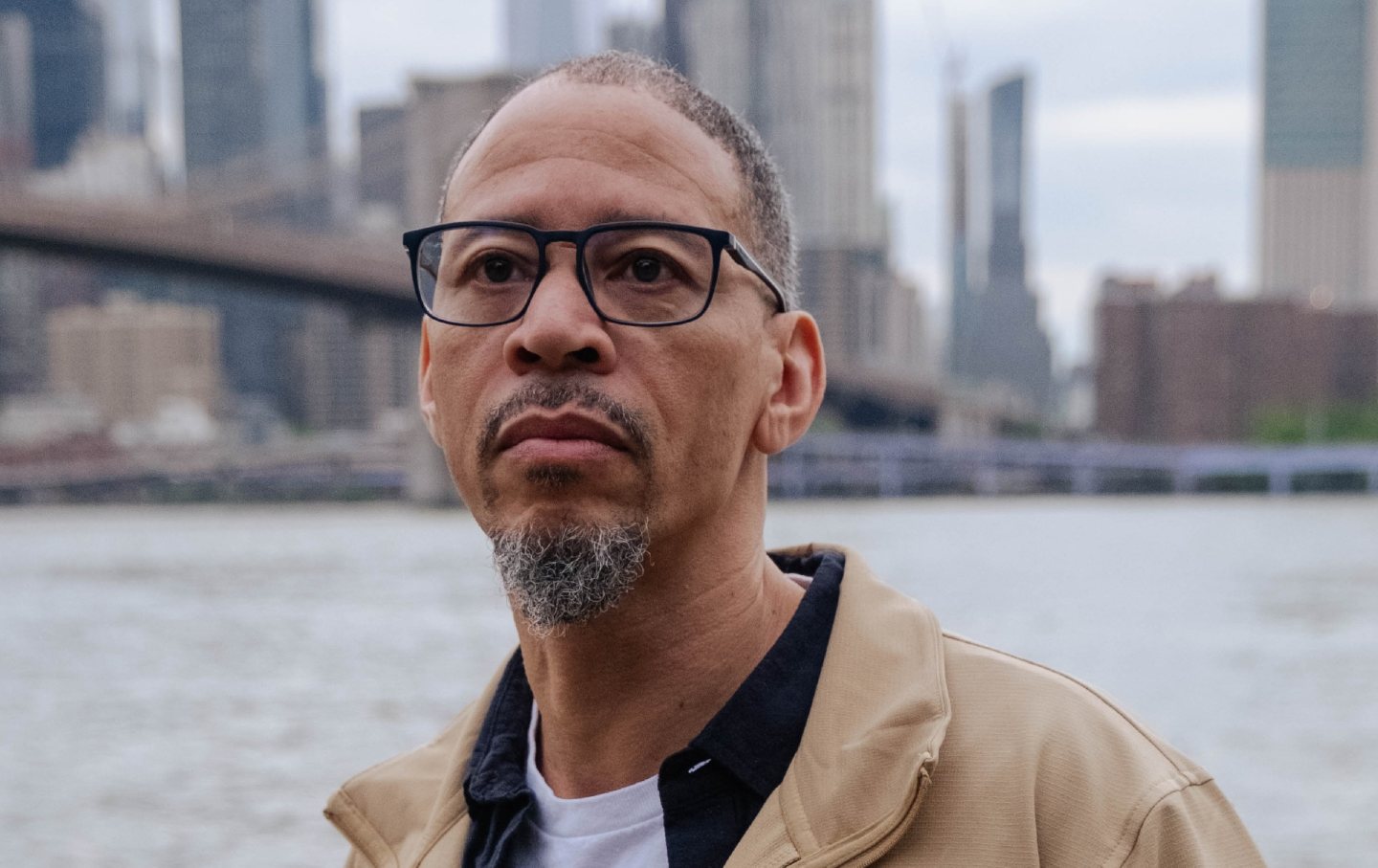Hard Times
The radical art of the Depression years.
The Radical Art of the Depression Years
By working within the constraints of the WPA, artists like Philip Guston discovered new modes of representation and irony.

The art of the 1930s occupies a unique place in American cultural history, for it was in the 1930s that art—so often a world apart from politics—became inseparable from the socialist, communist, and labor movements. When we think of the era, we think of the paintings, prints, murals, and photographs created under the auspices of the Works Progress Administration (WPA), and of the posters, propaganda, and other works created by artists affiliated with left causes in the 1930s—from members of the Communist and Socialist parties to those supporting the rank and file of the Congress of Industrial Organizations (CIO).
These were the documents of Depression-era hardship: testimonies to the resilience of those who lived through it and indictments of the capitalist system that had caused it. They are also works of art, rich with personal and political meaning and aesthetic value. And yet, especially these days, it can be difficult to shake a sense of homogenizing nostalgia that transforms what was a lively and contested cultural milieu into a blur of burly bodies and simple scenes of social realism.
“Art for the Millions,” a new exhibition at the Metropolitan Museum of Art, invites us to look with fresh eyes at the art of the 1930s and seeks to bring together lesser-known works and unexpected objects from the era to show the diversity and daring in the cultural production of this period.
“Art for the millions” opens with a section that focuses on the kinds of artistic engagement with left-wing politics and the labor movement that we associate with the era’s art. Yet even when the subjects are those you might expect—factory workers, protests, various social ills—the visions on view are individual, even idiosyncratic.
Take, for example, a mural design proposed by Philip Guston for the Queensbridge Houses Community Center in Queens. Somber and ominous, the colored-pencil study shows, against a foreboding urban skyline and among scattered construction fragments, a mother upright in her coffin and children dueling with two-by-fours and trash-can lids while a vagrant slumps across a stoop. Unsurprisingly, this scene of deprivation was rejected by the WPA in favor of a more uplifting image, and Guston’s completed mural focuses instead on the nuclear family, children at play, and the applied arts—although not without an unsettling, ironic edge that prefigures the artist’s later work, which features bubblegum-colored viscera and cartoonish images of Klan members driving around in cars.
The chasm between Guston’s proposal and the completed mural hints at the reason WPA work can be challenging to engage with as art, rather than as history or propaganda: Created for government-run facilities and subject to state-imposed constraints, it clashes with our ideals of artistic freedom. The WPA’s guidelines forbade overt political content (although it found its way in nonetheless) and steered artists toward legibility, prioritizing representation over abstraction and favoring the social realist aesthetic. Artists trying to get by in an era of mass unemployment had little choice but to accept these constraints. Yet this context makes the individual visions that shine through all the more meaningful. By working within such constraints, artists like Guston discovered new modes of representation and irony.
By including Black artists and images of Black workers, “Art for the Millions” challenges other dominant narratives of the Depression, the New Deal, and the art of this period. One such representation appears in a painting by Ben Shahn, an artist who created some of the era’s most arresting imagery.
Though he was happy to describe his work as propaganda, Shahn’s paintings were rarely straightforward. In the painting on view at the Met, the artist depicts a ruddy-complexioned man with his gaze lifted to the horizon. In the distance, scaffolding rises, reflected in the lenses of his welding goggles. Next to him, another welder, who is Black, looks into the middle distance with a furrowed brow. Shahn created this painting in 1943 while working in the graphics division of the CIO’s political action committee—established that year as the first PAC in American history. Reproduced as a poster, the work circulated among union members with the caption “For full employment after the war REGISTER—VOTE.” On its face, this painting presents a vision of racial solidarity within and beyond the workforce, suggesting the power that American workers could wield at the ballot box regardless of their background. Yet there is something more ambiguous at work: Its Black subject occupies an uneasy space in the composition, to the left of the white worker, squeezed into the corner and strangely cropped. I can’t help but feel that he is an afterthought, although compellingly rendered and despite the artist’s own anti-racist bona fides: Shahn was a member of the Committee for the Negro in the Arts, a diverse organization dedicated to the fight against discrimination in theater, the visual arts, music, and beyond.
The Black figure’s marginalization captures a deeper tension of the era: the exclusion of Black Americans from the post–World War II promise. Although Franklin Roosevelt’s 1944 State of the Union address would propose a Second Bill of Rights guaranteeing Americans the right to “a decent home” and “a useful and remunerative job,” state and local authorities enforced segregationist measures that denied Black Americans these advantages. Likewise, returning Black GIs found it difficult to enroll in colleges and gain meaningful employment. Meanwhile, discriminatory federal housing policy and redlining kept Black families from purchasing homes in new suburban developments. However unintentionally, Shahn’s painting recalls this history and reminds us of the unevenness with which the era’s supposedly universal assistance programs were applied.
Elsewhere in the exhibition, the Black figure appears front and center, yet similar tensions and contradictions remain. A 1940 watercolor by the Black painter and printmaker Dox Thrash suggests the complexities of union affiliation for Black workers. Thrash, better known for the richly toned and inky prints that he created using a method of his own invention, shows us a larger-than-life Black orator giving an impassioned speech. While the surrounding figures, also Black, are attentive, some seem unconvinced, standing with hands on hips rather than with fists raised. Two people—perhaps children—can be seen laughing from an open window in the background. While this image has been read as an affirmation of Black unionism, the apparent skepticism of the crowd reflects an on-the-ground reality.
At the time Thrash created this painting, major labor unions such as the CIO, which pledged to organize all workers regardless of color at its founding in 1935, had only recently taken steps to combat segregation and discrimination in their ranks. Thrash’s vociferous orator brings to mind the real-life Frank Custer in the 1984 TV masterpiece The Killing Floor, which follows Custer’s efforts to bring his fellow Black meatpacking workers into the Amalgamated Meat Cutters in the years leading up to the 1919 Chicago race riot. But there are deeper ambivalences at work too, including Thrash’s own attitude toward organized labor. In 1937, he wrote a letter to Ellen Woodward, an administrator of the Federal Arts Project, in support of Mary Curran, the director of the project’s Philadelphia branch, where Thrash was employed. Curran had been asking the artists under her to sign a letter rejecting the Artists Union, an organization that had pressured Roosevelt to extend New Deal employment relief to artists and that continued to vigorously advocate for working artists and strongly opposed reductions to the program. The Artists Union had accused Curran of mismanagement and anti-union activity, but Thrash praised her leadership. “As a negro artist,” he wrote, “I would like to commend the entire staff for their impartial and fair treatment to all those employed.” One of Thrash’s fellow FAP artists, Claude Clark, remembered Thrash’s own anti-union activity, recollecting that Thrash “seemed to feel that it was patriotic to stand across the street from the union hall and tell how many employees [of the FAP workshop] went into that meeting.” A close look at Thrash’s ambiguous painting may serve as a reminder that we cannot assume the politics of the artists of this period.
Despite the diversity of the visions of labor on view, the working body in “Art for the Millions” is consistently represented as male. Although millions of women entered the workforce during the Depression, it is the heroically masculine working-class body, broad-shouldered and burly, that has come to represent the era and its art.
Popular
“swipe left below to view more authors”Swipe →A compelling exception is a lithograph by the painter and illustrator Elizabeth Olds. Olds’s prints also valorize working men—her Miner Joe was chosen as the banner image for this show—but in this one, titled Burlesque, we find a tightly packed row of women in leotards, posed identically with bare legs flexed and extended. The mechanical quality of their movement, the precision and duplication in their pose, recalls representations of work on the assembly line, lampooned nearby in a clip from Charlie Chaplin’s Modern Times.
While Depression-era conceptions of labor were unlikely to include burlesque dancers, Olds’s print appears to frame entertainment as work and to suggest that performance is also a form of alienated labor, consumed here by the rapt, cigar-smoking audience squeezed into the corner of the image. Only recently have nightlife workers—strippers, dancers, door and coat-check workers—moved to unionize, shining a bright light on the uniquely precarious and exploitative conditions of this form of employment. In Olds’s prescient lithograph, we catch a glimpse of this broader understanding of the composition of the working class.
After the sections on leftist politics and labor in art, “Art for the Millions” shifts its focus to explore the broader search for an American cultural identity. What exactly was “American” about American art? This question concerned artists and critics alike during the 1930s and ’40s, reflecting longstanding anxieties about the perceived lack of a uniquely and cohesively American artistic tradition. As the show demonstrates, this search for an American cultural identity—far from encouraging or yielding a homogeneous vision of Americanness—resulted in a cacophony of contested expressions.
One case in point is the dazzling and meticulous drawings of American folk art on view. Among the jobs for artists created by the Federal Arts Project were those documenting objects of American craft, which were just beginning to be valued as art—from the head-shaped jugs created by enslaved artisans in Edgefield, S.C., to Navajo woven blankets. The intricate and exact renderings produced by these FAP illustrators (many of them women) formed an Index of American Design, a repository preserving American artistic traditions and serving as a resource for artists and designers. These drawings are works of art in their own right. The trompe l’oeil effect of a watercolor painting depicting the embroidery made by an anonymous woman from colonial New England had me looking twice—I thought I was seeing a textile fragment behind glass.
A few works in the show draw on the history and heritage of the American West in particular to stake competing claims to American artistic authenticity. In Frontier, a solo dance choreographed and performed by Martha Graham in 1935, a long-skirted female figure, her back to a split-rail fence, surveys the expanse before her, as suggested by her wide arms and smile, before dancing into a space she claims with brisk and competent movement. Graham’s celebration of female independence and ingenuity in the American West represents a landmark in the history of modern dance. Her explorations of expressive and communicative motion were aimed at creating a form that was “uniquely American.”
Later, during the Cold War, Graham’s work would be exported as a celebration of American creative liberty. In 1955, her company went on a State Department–sponsored tour of the East and South Asian “domino nations”—those that the Eisenhower administration deemed likely to come under communist influence. Yet in the 1930s, before they came to represent an artistic corollary for anti-communist liberalism, these experimental and modernist visions of American identity were explicitly opposed to another artistic movement gaining ground at the time: regionalism, which rejected the urban intellectualism of modern art and the influence of the European avant-garde and turned instead to rural America, its history, and its salt-of-the-earth inhabitants for inspiration.
Regionalism is represented in the Met’s show with a lithograph by Thomas Hart Benton, who had studied art in prewar Paris—the avant-garde’s ground zero—and claimed to have destroyed his early work “to get all that modernist dirt out of my system.” Titled Approaching Storm, it too commemorates the independence of the pioneer, represented here by a lone male figure who, alongside a team of mules hitched to a plow, watches dark clouds rise above a rolling agricultural landscape.
While Benton’s lithograph is ambiguous about its intentions, in the hands of regionalism’s big promoter, the gallerist Maynard Walker, the movement took on an explicitly nativist character. In 1933, Walker urged the art-viewing public to leave behind European “rubbish” and hew to “real American art…which really springs from American soil.” These overtures set off alarm bells for some, as news of developments in Germany began to circulate among America’s radical artists. In a 1936 article published in Art Front, the magazine of the Artists Union, the leftist critic and art historian Meyer Schapiro warned of the dangers of linking national identity and cultural production in the search for an authentic American artistic heritage. “Many liberal, and even radical, artists who uncompromisingly reject nationalism, share the belief in fixed racial or national characters in art,” Schapiro wrote. “We must denounce appeals for an American art which identify the American with a specific blood group or race, or which identify American art with supposedly fixed and inherent psychological characters inherited from the past.” The “American character,” Schapiro concluded, “is as varied as the American scene.”
While the modernist Graham and the regionalist Benton offered different formal and conceptual approaches to the American West, in neither Frontier nor Approaching Storm is there any suggestion of the Indigenous claim on and presence in the region. At the Met, however, Native relationships to the land can be glimpsed in the work of the Pueblo artist Quah Ah, who also went by the Spanish name Tonita Peña. Throughout the 1920s and ’30s, she created hundreds of paintings representing everyday life and ceremonial events in Pueblo communities.
In Peña’s Pueblo Parrot Dance, we find a sharp contrast to Graham’s and Benton’s evocations of pioneer independence. Instead, we see regalia-clad women and men moving past each other and into a center space between two lines of dancers, in a composition that balances order and movement. In their own moment, Peña’s paintings appealed to preservationists and tourists as timeless and “authentic” expressions of Indigenous culture. Yet Peña was a modern artist: Her experimentation with new modes of representing Pueblo communities reflects a Native modernism emerging in this period and a countercurrent within the search for an American cultural identity.
If much of the work on view in “Art for the Millions” reflects the era’s pluralism and diversity, the exhibition’s final section shows the streamlining of history. As the United States emerged from the Depression, populist art and politics gave way to narratives of technological and industrial innovation. New consumer goods in gleaming chrome promised luxury and efficiency, while the futuristic visions of the Chicago and New York world’s fairs conjured brave new worlds of progress. “Art for the Millions” puts on full display the magnetic, even seductive qualities of American design in this period. A sleek Bakelite baby monitor, or “Radio Nurse,” designed by the sculptor Isamu Noguchi is covetable. So is the “Streamliner” meat slicer, whose aerodynamic shape and tapering curves reflect the era’s belief that everything, from appliances to automobiles, could be engineered to achieve its optimal form. Also on view is ephemera from the era’s various world’s fairs. Postcards and silk scarves allowed attendees to take home souvenirs from “The World of Tomorrow,” as the 1939 New York World’s Fair was dubbed.
Some of the most eye-catching images in this final section are from a series of Fortune magazine covers from January to December 1937. A magazine created to cover both business and culture, Fortune was a deluxe publication, amply illustrated and printed on heavy stock. Its covers are full of slick modernist citations: a sinuous snare of stock ticker tape; an abstract field of ships’ stacks emblazoned with shipping-line logos, like a Mondrian composition; a surrealist, trompe l’oeil treatment of the transformation of raw lumber into newspaper. At the exhibition’s end, these covers stand in contrast to those of the leftist periodicals on view in the first gallery—the Daily Worker, New Masses, Labor Defender, and the Yiddish-language monthly Der Hammer—which illustrated, with photocollage and bold symbolism, the era’s struggles against political and economic oppression. These two sets of magazine covers bookending the exhibition recall to me the cultural historian Michael Denning’s provocative suggestion that the visual expressions of working-class consciousness in American art, however familiar they may seem today, constituted a genuinely radical avant-garde, a modernist aesthetic for the masses.
I admit to being wary as I approached this exhibition, worried that I (as well as others) might feel unmoved by the familiar. But if this Depression-era art does feel familiar, it’s for a good reason. Perhaps more than any other artistic movement of the 20th century, the art of the 1930s and ’40s has become a living legacy. WPA murals, prints, and paintings adorn our schools, post offices, hospitals, government buildings, and public housing projects. Their presence, in these spaces and in exhibitions like the Met’s, might evoke nostalgia for a time gone by. But we can also allow these works to remind us of a moment when artists, along with countless others, organized to bring not only art, but so much more, to the millions.
More from The Nation

What Luigi Mangione and Daniel Penny Are Telling Us About America What Luigi Mangione and Daniel Penny Are Telling Us About America
When social structures corrode, as they are doing now, they trigger desperate deeds like Mangione’s, and rightist vigilantes like Penny.

Banning Trans Health Care Puts Young People at Risk of Harm Banning Trans Health Care Puts Young People at Risk of Harm
Contrary to what conservative lawmakers argue, the Supreme Court will increase risks by upholding state bans on gender-affirming care.

It’s Still Not Too Late for Biden to Deliver Debt Relief It’s Still Not Too Late for Biden to Deliver Debt Relief
Four years after hearing the president promise bold action on student debt, most borrowers are still no better off, and many—especially defrauded debtors—are measurably worse off....

It’s Been a Tough Year. Let’s Help Each Other Out. It’s Been a Tough Year. Let’s Help Each Other Out.
There may be a dark shadow hanging over this year’s holiday season, but there are still ways to give to those in need.

Prison Journalism Is Having a Renaissance. Rahsaan Thomas Is One of Its Champions. Prison Journalism Is Having a Renaissance. Rahsaan Thomas Is One of Its Champions.
Thomas and his colleagues at Empowerment Avenue are subverting the established narrative that prisoners are only subjects or sources, never authors of their own experience.

Luigi Mangione Is America Whether We Like It or Not Luigi Mangione Is America Whether We Like It or Not
While very few Americans would sincerely advocate killing insurance executives, tens of millions have likely joked that they want to. There’s a clear reason why.


